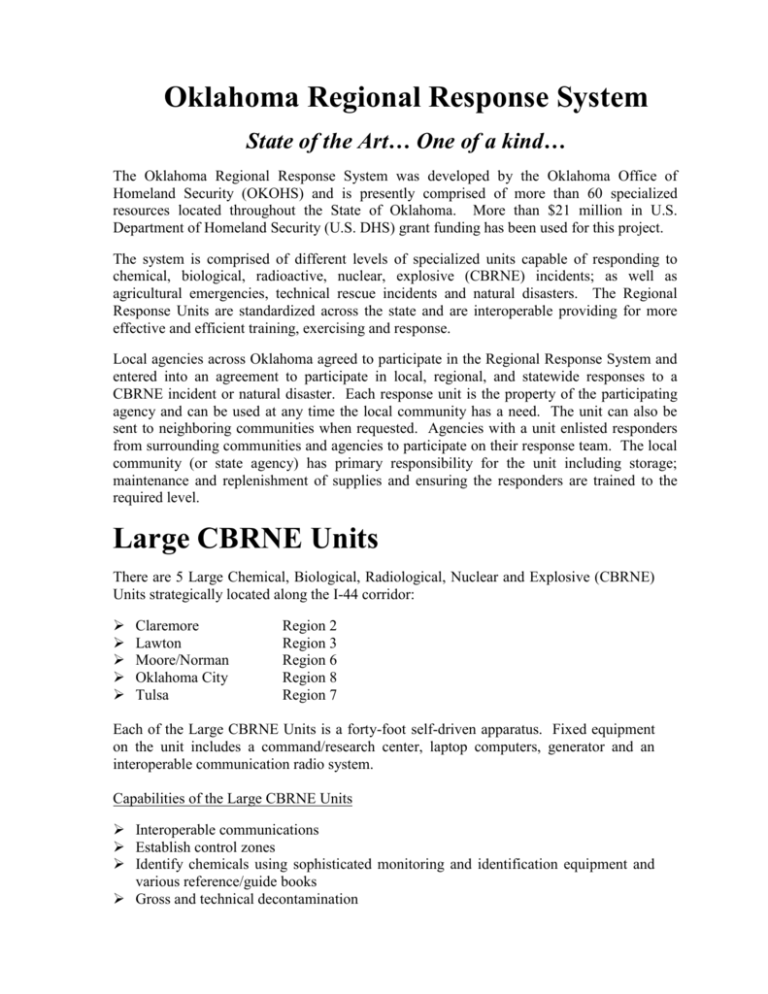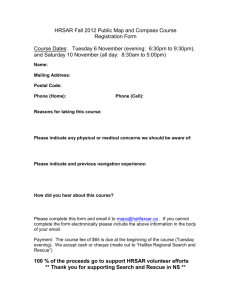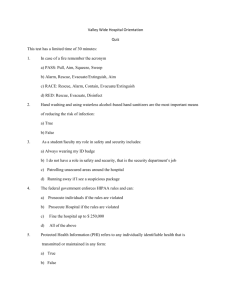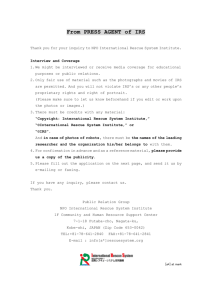DOC
advertisement

Oklahoma Regional Response System State of the Art… One of a kind… The Oklahoma Regional Response System was developed by the Oklahoma Office of Homeland Security (OKOHS) and is presently comprised of more than 60 specialized resources located throughout the State of Oklahoma. More than $21 million in U.S. Department of Homeland Security (U.S. DHS) grant funding has been used for this project. The system is comprised of different levels of specialized units capable of responding to chemical, biological, radioactive, nuclear, explosive (CBRNE) incidents; as well as agricultural emergencies, technical rescue incidents and natural disasters. The Regional Response Units are standardized across the state and are interoperable providing for more effective and efficient training, exercising and response. Local agencies across Oklahoma agreed to participate in the Regional Response System and entered into an agreement to participate in local, regional, and statewide responses to a CBRNE incident or natural disaster. Each response unit is the property of the participating agency and can be used at any time the local community has a need. The unit can also be sent to neighboring communities when requested. Agencies with a unit enlisted responders from surrounding communities and agencies to participate on their response team. The local community (or state agency) has primary responsibility for the unit including storage; maintenance and replenishment of supplies and ensuring the responders are trained to the required level. Large CBRNE Units There are 5 Large Chemical, Biological, Radiological, Nuclear and Explosive (CBRNE) Units strategically located along the I-44 corridor: Claremore Lawton Moore/Norman Oklahoma City Tulsa Region 2 Region 3 Region 6 Region 8 Region 7 Each of the Large CBRNE Units is a forty-foot self-driven apparatus. Fixed equipment on the unit includes a command/research center, laptop computers, generator and an interoperable communication radio system. Capabilities of the Large CBRNE Units Interoperable communications Establish control zones Identify chemicals using sophisticated monitoring and identification equipment and various reference/guide books Gross and technical decontamination Contain and mitigate hazardous liquids and gaseous product from damaged cylinders and apparatus Basic emergency medical procedures Large CBRNE Team 20 team members (at a minimum): 15 trained to the hazardous materials technician level 5 trained to the hazardous materials operational level Intermediate CBRNE Units There are 12 Intermediate Chemical, Biological, Radiological, Nuclear and Explosive (CBRNE) Units strategically located across the state: Altus Ardmore Chickasha Edmond Enid McAlester Region 3 Region 3 Region 3 Region 8 Region 1 Region 5 Muskogee Sapulpa/Sand Springs Shawnee Stillwater Tahlequah Woodward Region 4 Region 2 Region 6 Region 2 Region 4 Region 1 Each of the Intermediate CBRNE Units has a 38-foot trailer equipped with a quad-cab four-wheel drive tow vehicle. The tow vehicle is designed to pull the trailer. However once on scene it has the capability to disconnect from the trailer and be used for other needed functions such as transporting responders and equipment closer to the incident. Additional fixed equipment includes a command/research center, laptop computers, satellite receiver, light tower, generator, and an interoperable communications system. Capabilities of the Intermediate CBRNE Units Interoperable communications Establish control zones Identify chemicals using sophisticated monitoring and identification equipment and various reference/guide books Gross and technical decontamination Contain and mitigate hazardous liquids and gaseous product from damaged cylinders and apparatus Provide satellite internet connection for laptop computers Basic emergency medical procedures Intermediate CBRNE Team 9 team members (at a minimum): 7 trained to the hazardous materials technician level 2 trained to the hazardous materials operational level Intermediate Technical Rescue Units There are 8 Technical Rescue Units strategically located across the state: Ada Blackwell Broken Arrow Cushing Region 3 Region 2 Region 7 Region 2 Durant Guymon Seminole Weatherford Region 5 Region 1 Region 5 Region 1 Each of the Technical Rescue Units has a 38-foot trailer equipped with a quad-cab fourwheel drive tow vehicle. The tow vehicle is designed to pull the trailer. However once on scene it has the capability to disconnect from the trailer and be used for other needed functions such as transporting responders and equipment closer to the incident. Additional fixed equipment includes a command/research center, laptop computers, satellite receiver, light tower, generator, and an interoperable communications system Capabilities of the Intermediate Technical Rescue Units Interoperable communications Structural collapse rescue High angle rescue Confined space rescue Cave in/Trench rescue Intermediate Technical Rescue Team Minimum of 9 specially trained personnel in NFPA 1670 rescue operations level Auxiliary Rescue Units Each of the 8 Technical Rescue Units has one Auxiliary Rescue Unit (ARU) as part of the equipment cache. Additional Auxiliary Rescue Units are located in the following: Eufaula * Miami * Purcell * Region 4 Region 2 Region 6 The Auxiliary Rescue Unit is a multifaceted, self-contained rescue trailer. A 44 horsepower diesel engine and a 20KVW generator power the units. Fixed equipment includes a full range of hydraulic core technology extrication tools, two 900-watt light towers, a breathing air compressor system, four cascade air tanks and storage for additional equipment. All of this is encased in a trailer that can be easily pulled by a 1-ton pick-up. Capabilities of the Auxiliary Rescue Units Rapid deployment of primary or secondary emergency equipment Extrication equipment for vehicular, agricultural, and industrial incidents Lighting to assist in nighttime emergencies Provide breathing air to refill cylinders on the emergency scene Provide constant air source for air equipment needs Provide a source for electricity at incidents Auxiliary Rescue Unit Team * For the three communities with just the Auxiliary Rescue Unit: At least 6 responders trained in Vehicle/Machinery Extrication Small Decontamination Units There are 24 Small Decontamination Units strategically located across the state: Altus Atoka Bartlesville Bixby Blackwell Broken Bow Duncan El Reno Grove Guthrie Henryetta Hugo Region 3 Region 5 Region 2 Region 7 Region 2 Region 5 Region 3 Region 6 Region 2 Region 6 Region 4 Region 5 Jones Laverne Muskogee Newalla Owasso Pauls Valley Pocola Ponca City Sallisaw Tahlequah Cordell Yukon Region 8 Region 1 Region 4 Region 8 Region 7 Region 3 Region 5 Region 2 Region 4 Region 4 Region 1 Region 6 The Small Decontamination Units consist of a 14-foot trailer equipped with an electric generator, decontamination tent/shelter, and the associated equipment necessary for the decontamination process. These Units work in conjunction with the Large and/or Intermediate Chemical, Biological, Radiological, Nuclear and Explosive (CBRNE) Units to provide decontamination of victims and/or responders exposed to hazardous substances. Capabilities of the Small Decontamination Units Technical decontamination at a rate of approximately 50 per hour Command center Rest and recovery center Medical treatment/triage Personnel staging area Small Decontamination Unit Team Minimum of 6 trained to the hazardous materials operational level Mass Decontamination Units There are 2 Mass Decontamination Units: Oklahoma City Tulsa Region 8 Region 7 Each of the Mass Decontamination Units is a self-driven apparatus that has the decontamination system enclosed in the unit. Fixed equipment on the unit includes generator, hot water capability and an additional shelter for outdoor decontamination. Capabilities of the Mass Decontamination Units Capable of decontaminating victims and/or responders at a rate of 150 – 200 people per hour Rest and recovery center Medical treatment/triage Personnel staging area Mass Decontamination Unit Team 10 trained to the hazardous materials operational level Urban Search and Rescue Units There are 2 Urban Search and Rescue Units: Oklahoma City Tulsa Region 8 Region 7 These two units have high-level rescue capabilities, equipment and training similar to the FEMA US&R teams. Each of the Urban Search and Rescue (US&R) Units includes a 42-foot trailer and tow vehicle. The equipment cache is based on FEMA US&R requirements. Both teams have additional equipment including three (3) quad-cab, four-wheel drive, one-ton trucks; a bobcat with attachments; and a 27-foot enclosed trailer to transport the bobcat. Capabilities of the Urban Search and Rescue Units Heavy structural collapse High angle rescue Confined space rescue Cave in/Trench rescue Canine search for trapped victims Urban Search and Rescue Team Teams consist of 125 members each enlisted from 33 agencies from both metropolitan areas. Team members are trained to the level of structural collapse technician. Additional specialized training includes: Medical Specialist, Technical Information Specialist, Structure Specialist, Heavy Equipment and Rigging Specialist, Technical Search Specialist, Canine Search Specialist, Logistic Specialist, and Communication Specialist. Agriculture Cleaning and Disinfecting Units There are six Agriculture Cleaning and Disinfecting Units located across the state: City of Atoka Carter County Oklahoma County Region 5 Region 3 Region 8 Tahlequah/Cherokee County Region 4 Texas County Region 1 Washington County Region 2 The Agriculture Cleaning and Disinfecting Units consist of a __-foot trailer equipped with a power washing system, disinfectant/chemicals, generator and other necessary equipment needed to disinfect livestock transport vehicles and other agricultural equipment contaminated during an animal disaster. Capabilities of the Agriculture Cleaning and Disinfecting Units Agriculture Cleaning and Disinfecting Unit Team Minimum of __ trained to the ______ level Mobile Communications and Command Unit A Mobile Communications and Command Unit is located at the Oklahoma Highway Patrol in Oklahoma City. This tractor-trailer unit has been designed to function as a command and communications unit that is available to respond during local or state disasters. The Mobile Communications and Command Unit has the capability to “bridge” different city, county, tribal and/or state agency radio communications systems when set up at an emergency anywhere in the state. The Mobile Communications and Command Unit is designed to handle large, multi-disciplinary, multi-jurisdictional events. Capabilities of the Mobile Communications and Command Unit Interoperable communications Multiple ports for radio, computer and telephone equipment Command Center Personnel staging area Mobile Communications and Command Team 4 team members (at a minimum): Team members are from the Oklahoma Highway Patrol, Oklahoma Department of Emergency Management and the Oklahoma Military Department who have communications, electronics and computer operations experience have been trained to use the sophisticated computer and communications equipment in the Mobile Communications and Command Unit during any type of emergency. Logistical Support Response Unit A Logistical Support Response Unit is located at Oklahoma State University Fire Service Training (OSU-FST) in Stillwater. This tractor-trailer unit has a large air compressor, a large cache of self-contained breathing apparatus (SCBA) and extra SCBA cylinders. Fixed equipment on the unit is similar to the Large and/or Intermediate Chemical, Biological, Radiological, Nuclear and Explosive (CBRNE) Units and can respond during major incidents to provide logistical support to the Regional Response System. Capabilities of the Logistical Response Unit Provide breathing air to refill cylinders and cascade system on other Regional Response Units Provide electrical power to support other Regional Units Portable and Tower lighting capabilities Communication capabilities Additional Personal Protective Equipment Logistical Support Response Team 12 trained to the hazardous materials operations level





